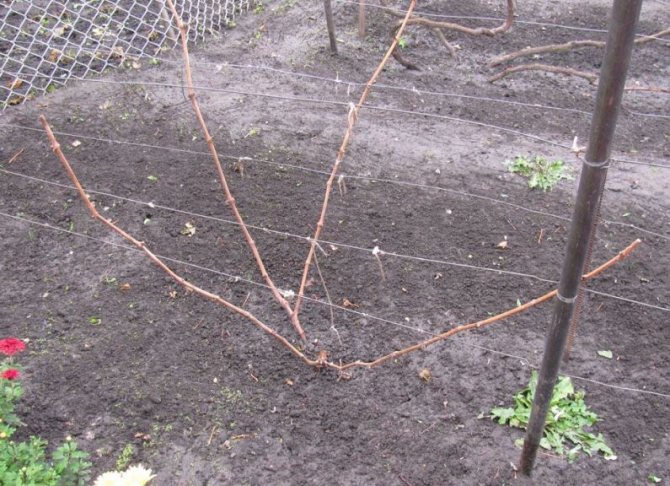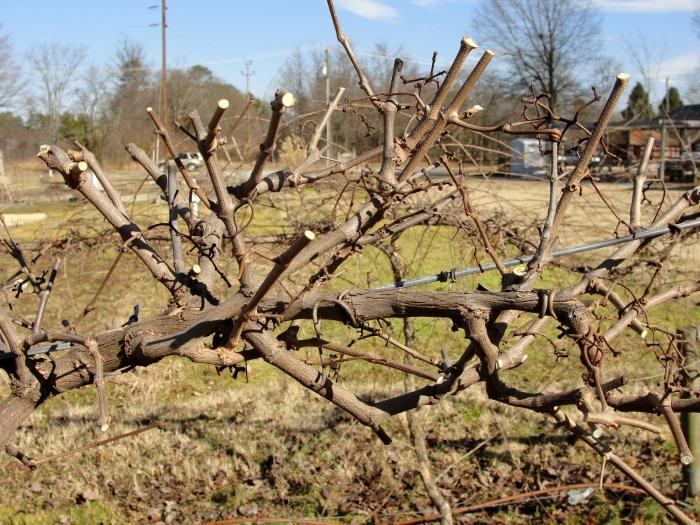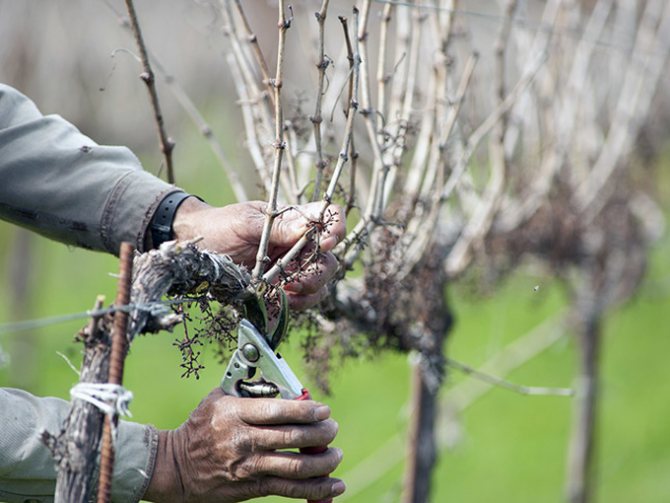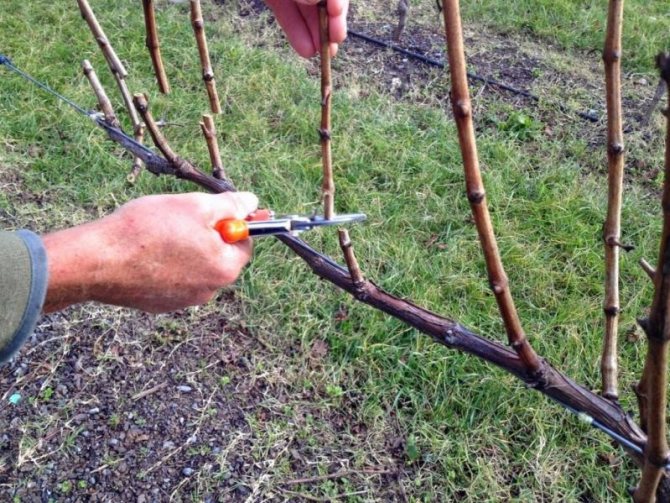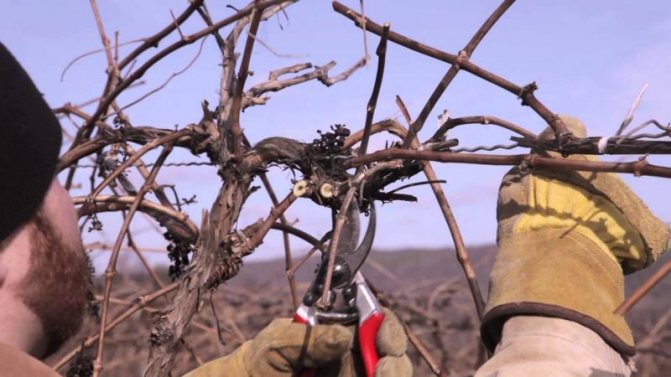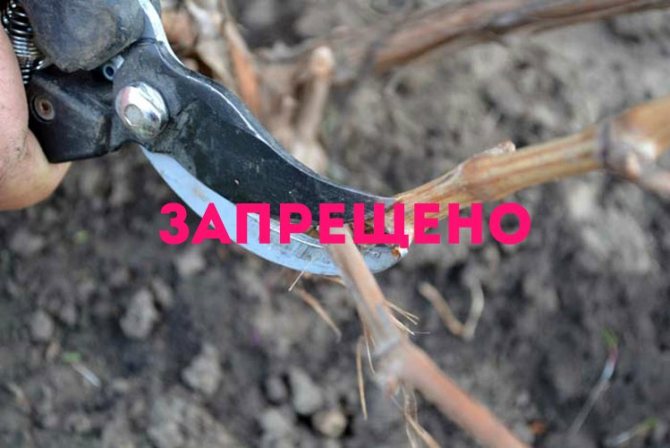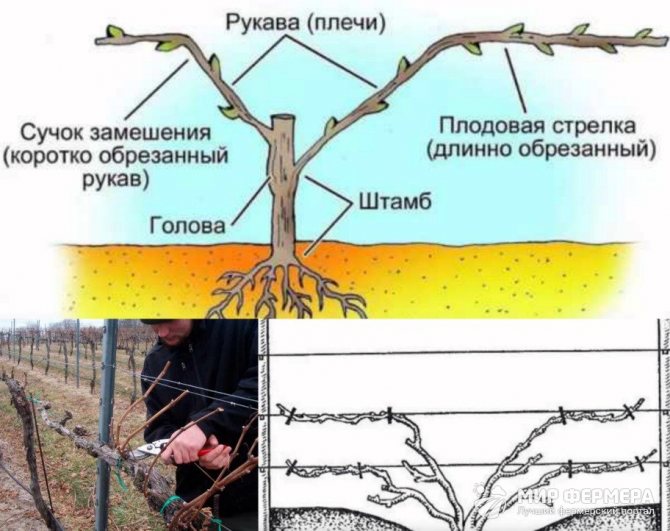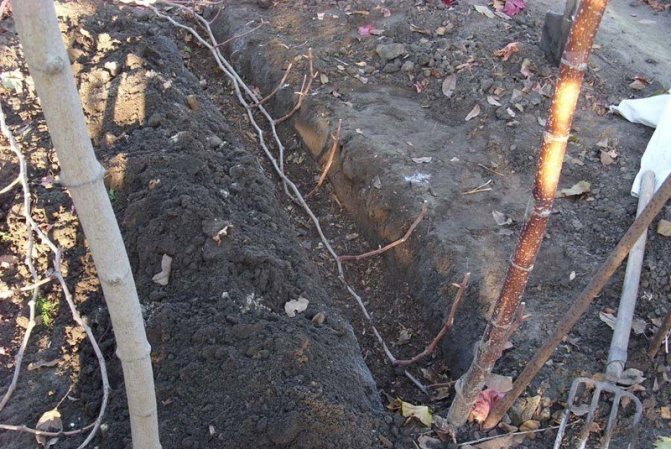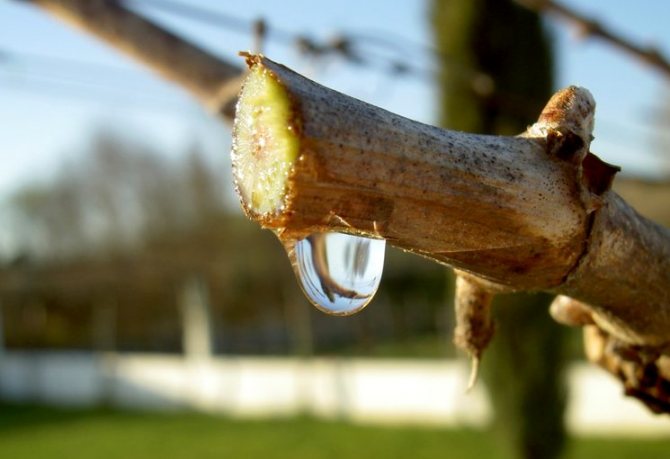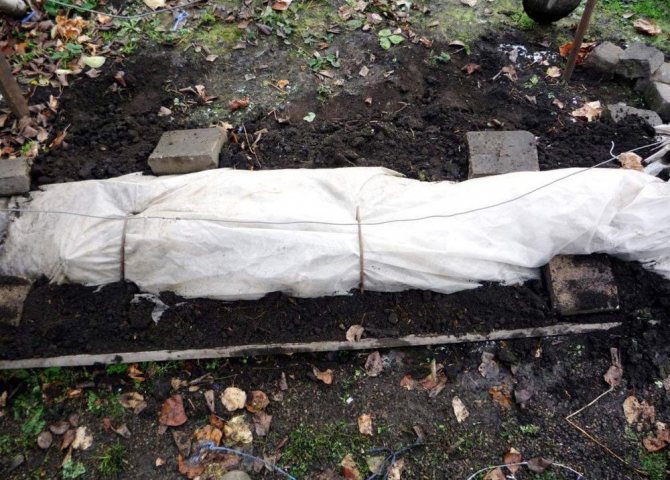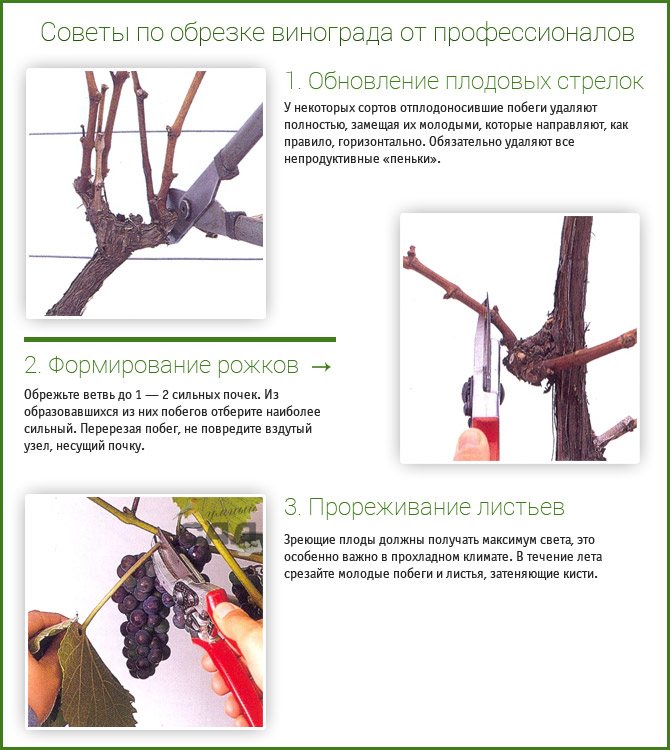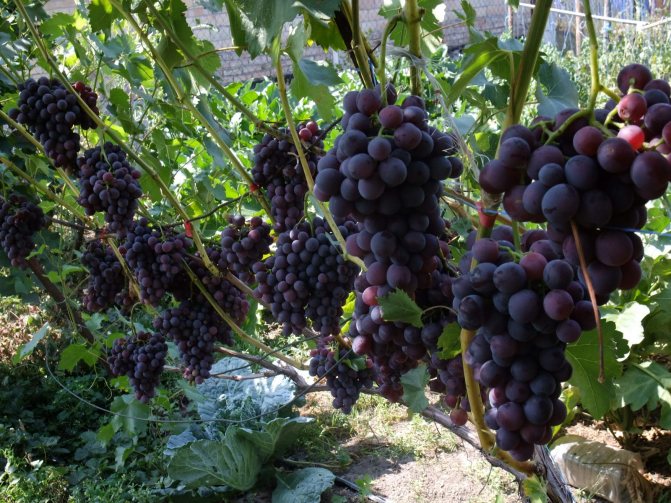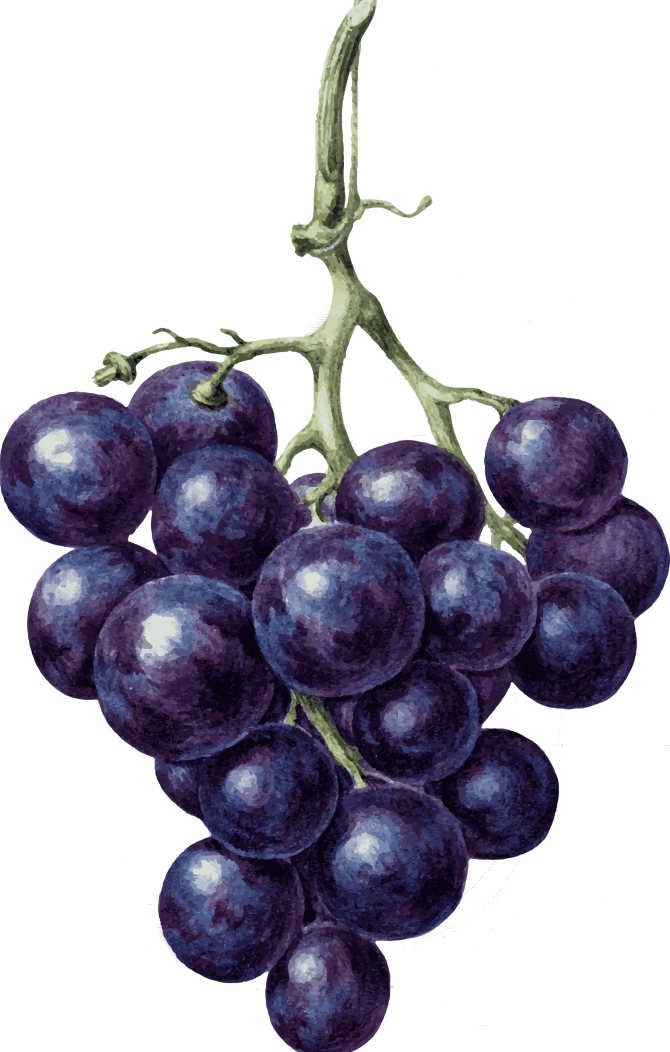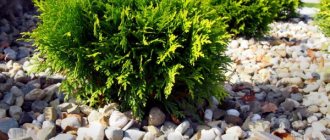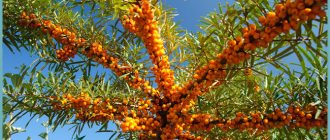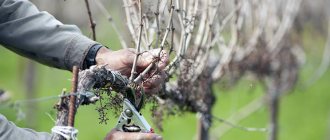Preparation of the vineyard for wintering begins with pruning and ends with a shelter. The harvest of the next year, the strength of growth and fruiting, the longevity of the plant depend on this procedure no less than on the variety and age of the vine. Thanks to the possibilities of autumn pruning, the bush becomes compact as painlessly as possible, because sap flow slows down by this moment. And a properly formed fruit link guarantees an excellent grape harvest in the garden.
- 2 Basic rules for pruning vines in the fall
2.1 Types of pruning
- 2.2 Formation of the fruit link
2.2.1 Photo gallery: pruning grapes with different formations of the bush
- 2.3.1 Video: how to properly prune grapes in the fall
Basic care activities
To obtain a stable and plentiful harvest, careful preparation is required in the autumn, increasing the protective properties of the plant.
Autumn watering
After the berries from the grapes are harvested, there is no need to water the plant. Especially if it's not hot outside. But in October it is imperative to water the grape bushes.
Watering should be abundant so that the water can moisten the topsoil. Autumn watering is extremely important as it helps the plant adapt to the coming frost.
In order for the root system of the grapes to receive the required amount of moisture, it is recommended to make small ditches near each of the bushes and place plastic tubes in them. This will direct the water directly to the roots.
In the first days after moistening the soil, it is advisable to keep an eye on its density. If the soil is flattened, it is necessary to loosen it slightly.
Processing and spraying grapes
When harvesting, it is recommended to take a close look at the condition of the plant. Are there signs of any disease or pest insects?
It is much easier to carry out preventive measures to eliminate pathogens in the autumn period. Since the berries have already been harvested, you can safely use the strongest drugs without the risk of spoiling the harvest. As a prophylaxis of diseases, it is advisable to treat grape bushes with the following preparations: "Amistar" (for insects) and cumulus solution (for powdery mildew).
The processing process is carried out taking into account some of the nuances:
- Spraying is carried out exclusively on days when there is no strong gusty wind. It is permissible to carry out processing in the evening when the sun goes down.
- Spraying in no case should be carried out in the rain, or during the flowering period of the grapes.
- When spraying, shake the product used periodically. The leaves of the grapes should be covered with the thinnest film of the preparation, the liquid should not drain onto the soil.
If you did not have time to carry out the treatment in the fall, you can spray the grapes in the spring.
Fertilizing grapes
At the onset of the first autumn days, carefully dig up the soil around the grape bushes. Then mix bird droppings with compost or manure mixture into it. The organic nature of the fertilizers used makes it possible to improve the quality of the soil, as well as to saturate it with oxygen. After that, you can additionally loosen the soil.
Few people know, but it is permissible to mix bird excrement used as fertilizer into the soil in liquid form. Referring to the advice of experienced gardeners, this is even preferable. To obtain the required consistency, it is recommended to prepare the composition in advance.
For 9 days, poultry droppings are diluted with warm water, in a ratio of 1: 3, respectively. Then the resulting mixture is placed in a dark, but not cool place. Before use, the fertilizer is once again diluted with warm water, this time in a ratio of 1: 8, respectively. The processing of one grape bush will require approximately 0.4 liters of liquid.
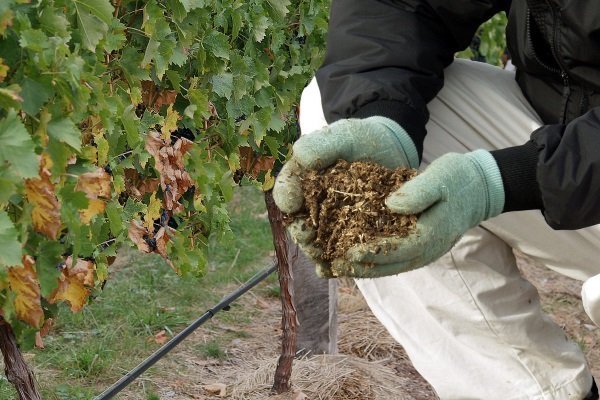
Pruning: chasing and stitching
Procedure coinage do not spend in dry seasons or if there is excessive soreness of the shoots (powdery mildew, mildew, etc.). The grapes are pruned when the growth of the shoots has stopped, and the internodes from the bottom have begun to ripen. In case you hurry up with trimming the tops. Stepchildren will begin to develop strongly, and the vines will stop growing well. Accordingly, the overall yield falls. Late coinage will also not be effective.
Early coinage can be done to allow stepchildren to grow quickly. Especially after winter freezing. This will help align the shaping of the bush.
Passionateness can be partial or complete. The main task is to remove lateral shoots and leaves, which contributes to the redirection of nutrients to the bunches and fruits. Timely removal of stepchildren will make it easier to care for bushes and control pests and diseases. Typically, they are pinched off two or three times per season. Breaking them out completely is undesirable, as this will damage living kidneys.
Thus, pruning of grapes is a necessary procedure, since it affects various processes of the plant's life. This contributes to the healing and uniform development of the bush as a whole, and also minimizes the likelihood of freezing and various diseases. Moreover, pruning has the most positive effect on the flavor, juiciness, sweetness and healthiness of the berries. If the event is carried out in a timely and correct manner, the culture will delight you with a rich harvest.
Pruning a grape bush
Forming the crown of vines by pruning is one of the most creative and responsible activities in the cultivation of this fruit crop. The vine must be shaped so that it can adapt to the local climate without interfering with winter shelter.
The ways
There are several ways to prune the vine. Let's consider each of them in more detail.
Short
For this pruning method, no more than 4 eyes are left on the shoots. They are called bitches. Short pruning is carried out exclusively on young vines in order to strengthen the root system. Due to the fact that more than half of the annual shoots are removed, a dynamic development of the shoot from the bud takes place.
Average
This method is one of the most common among vineyard owners. Average pruning assumes no more than 10 eyes on the shoots. The branches on which the grape clusters grow can take the form of a horizontal arc, or bend strongly towards the ground.
This method of forming a bush allows you to ensure high fruiting, while not reducing the quality of the berries.
Long
This method of pruning a vine bush requires no more than 20 buds on the shoots. Long pruning is ideal for vigorous plants commonly found in Central Asian grape varieties. With the correct procedure, the grapes begin to bear fruit better already in the next season.
Mixed
Fruit link pruning is an alternative name for mixed pruning. Quite often, this method is resorted to in small vineyards.Systematic cutting of a new shoot makes it possible not to lose high yields and fruit juiciness.
Pruning depending on the age of the grapes
One of the characteristics of the grape is the suspension of the growth of the vine. This is due to the formation of buds on the lower half of the plant, which causes the dynamic growth of shoots on last year's vine. The bushes expand, and the distance from the root system to the crown becomes more and more.
This situation leads to a deficiency of nutrients in the root system, and it begins to fade. The solution to the problem was the autumn pruning of the crown, which is carried out taking into account the age of the plant.
First year
In the first months of spring, it is necessary to leave 2 lower buds at the plant, remove the rest. Subsequently, shoots will appear from these buds, which must be fixed in such a way that they are tilted in different directions from each other.
At the onset of autumn, after the foliage from the vines has fallen off, it is necessary to shorten the shoots. One of them is cut short, the next is left unchanged. Thus, only 4 buds remain for the winter.
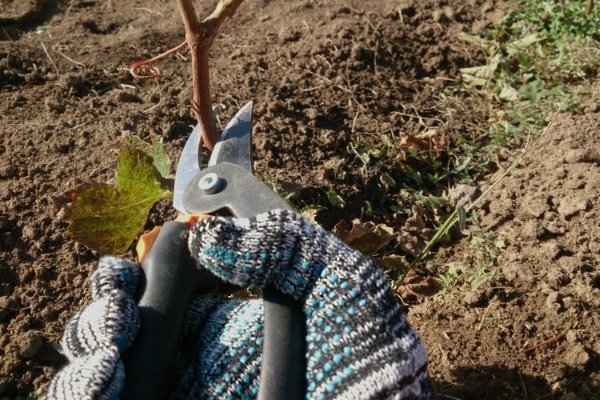

Second year
After the foliage on the plant has fallen off, the long sleeves of the grape bush are pruned. Only 2 shoots are left. In this way, the symmetry of the vines is achieved.
After they begin to trim the vertical stems, that is, those that are located closer to the middle. Again, all shoots are cut, with the exception of 2 buds. They will act as “replacement knots”.
The remaining vertical stems, which are located at the edges, are also cut off. This time it is necessary to leave 4 buds, which will play the role of fruit arrows. After the manipulations done, the grape bush can be prepared for winter.
Third and subsequent years
It should be noted that when spring comes, in the third year of the growth of the vine, the grown fruit arrows are fixed in a horizontal position closer to the ground, while the tops of the bush are pulled vertically in different directions. The replacement knot should also grow in an upright position.
During the summer season, the buds will give new shoots in the form of young stalks. By the end of August, there should be the first cutting of the stalks by 15 cm. The performed procedure will soon provoke an increase in the juiciness and volume of ripe berries.
It is worth noting that pruning performed earlier than August contributes to the emergence of a large number of unnecessary shoots on the vines.
Within a few days after the leaves have fallen, you will need to prune each of them from the fruiting vertical shoots. All 4 extreme shoots are cut off. Thus, each shoulder of the bush remains with one link of two vertical shoots.
Their pruning is carried out in the same way as in the second year of growth of the vine. Shoots close to the middle are also minted. Those in the center are cut, leaving only 2 buds.
The extreme shoots are cut off too, but this time 4 buds are left. Pruning in the following years will be carried out according to the same principle as described in the third year of growth of the grape bush.
If desired, you can leave more buds on the shoot. This is quite acceptable, since there is always the possibility that several of them will be injured when frost and insufficiently good shelter occur. However, it is not recommended to leave more than 10 buds on one shoot, this will provoke active growth of the vine.
Watch a video on how to tidy up a perennial grape bush with the help of an annual pruning of excess vines and the formation of classic fruit links on all sleeves:
Why you need to prune grapes in the fall
Pruning in the spring is acceptable in the southern regions, as well as when grown in the middle lane of uncovered grape varieties. In all other cases, gardeners prefer the autumn period for the procedure.
- Most of the table grape varieties in the middle lane are grown using a covering method. Therefore, the protection of an untreated bush is fraught with a number of inconveniences and difficulties.
- In the fall, the cuts on the vines are quickly tightened, and the spring procedure in the middle lane often leads to the appearance of sap. The situation is complicated by diseases and general weakening of the plant.
- Any pruning is a powerful incentive for the bush to set flower buds. Therefore, autumn work on the formation of correct growth in the middle lane is a guarantee of an abundant harvest even on young vines.
Top dressing of grapes for the winter
Each year, grapes extract a large amount of micronutrients from the soil to produce a bountiful and ripe harvest. If in the autumn months you do not replenish the supply of nutrients, then by the spring the grape bushes will not find the strength for dynamic growth and development. Subsequently, this can lead to wilting of the plant. To prevent this, use the help:
- potassium solution, which contributes to the rapid ripening of berries and helps the plant to overwinter;
- copper solution, which increases the resistance of the fruit crop to frost.
From organic fertilizers, you will need to get compost (or manure), chicken droppings and wood ash. Top dressing is not poured under each grape bush. You will need to make small indentations along the entire diameter of the bush at a distance of 30 cm from the center of the rhizome. In these grooves, top dressing is laid out or poured. This feeding method is more effective.
Read more about the autumn feeding of grapes in our other article.
Recommendations
- It will be better if the cuts on the branch are located on its inner part. So the wounds will heal faster.
- The sharpened secateurs ensure a smooth cut. Otherwise, torn edges will slow down the flow of sap along the vine, which will affect the health and productivity of the bush.
- The pruner should be pointed with a thin blade towards the vine to be trimmed.
- One-year-old shoots and shoulders must be removed completely, without hemp.
- Top shoots are removed at a depth of 15 cm.
- On a one-year-old vine, 1 cm is left above the eye.
Subject to the pruning technology, grapes will delight owners for a long time with a delicious taste and amount of harvest. In addition, having shown the proper imagination, you can decorate the site in an original way with grape vines and hide the not very aesthetic parts of the garden.
Shelter for the winter
There are 2 popular methods for creating shelter for a vine:
- First, remove the vine from the support beam and spread it over the pre-covered coniferous branches. Then tie them together and secure with any available wire or twine. Fold another layer of coniferous branches 6-12 cm on top of the plant. Next, carefully lay out the boards and lay the roofing material. The latter can be replaced with a conventional industrial film.
- Fix two adjacent vines together and bend to the ground. This is done using arcs. They can be wooden or metal. The distance from the vine to the soil should be at least 8 cm. Lay planks on the sides, on top - several layers of reed. To prevent the structure from getting wet, wrap it with industrial film. Such a homemade shelter is very practical, because thanks to the reed reeds, the grapes will not freeze or rot.
Caring for grapes after pruning
Upon completion of all work, the vines are removed from the trellises and laid on the ground. It can be covered with spruce branches or pieces of styrofoam. This is necessary in order to exclude as much as possible direct contact of the branches with the ground.When stable sub-zero temperatures are established below -5 ° C in the middle lane, you need to start the procedure for sheltering the grapes.
The need to prune grapes in the fall in the middle lane is caused by the peculiarities of his agricultural technology in a sharply continental climate. The cultivation of table varieties is possible only if there is a shelter for the winter, and this is unacceptable without preliminary processing.
Similar posts
- How to prune grapes in the fall
- How to care for grapes in autumn
- Grape processing in autumn
- Top dressing of grapes in autumn
- Propagation of grapes by cuttings in autumn
Features of preparation for winter
It is advisable to cover the grape bushes with shelter only after the onset of the first frosts. The branches of the plant should be slightly hardened. It is recommended to leave it without any shelter for 3-4 days.
The permissible hardening temperature for grapes is from -6 to -9 degrees. A lower temperature will provoke the death of the fruit crop. The hardened bushes will acquire a brownish tint of the leaves. This suggests that the plant has matured, which means it will perfectly survive the winter.
In the first year
A young plant, which has to survive the difficulties of the first frosts, is required to put up a shelter without fail. This can be done in one of any of the above ways.
Young grapes are covered in the first days of November, when the plant is still elastic and easily laid to the ground. In no case should the plant bend strongly, the root system may be damaged.
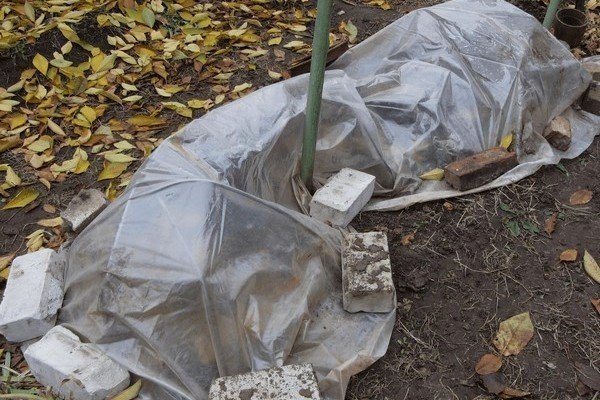

Young bush
For vines that have successfully coped with the first winter, by the next frost, shelter in the form of a "house" is still required, in which the vines do not need to bend to the ground. This is due to the fact that the plant is still not strong enough and may be injured.
Before covering the grapes, it is advisable to feed the plant with phosphorus and nitrogen fertilizers. They will allow young animals to be nourished with useful substances and microelements to make it easier to endure the winter period. This recommendation is more relevant for young plants.
Old grapes
Partial shelter can be created for perennial vines that have adapted to frost over the years. It is enough just to carefully lay the vine on the coniferous branches and throw snow on top. Older vines often need pruning and crown shaping. If you do not carry out this procedure before the onset of the first frost, then in the spring the bushes can grow greatly.
Grapes are a rather difficult fruit crop to care for. Winter preparatory work is an extremely important step for any vineyard. The better and more thoroughly the pruning is done, the shelter is made and the plant is well fed with fertilizers, processed and sprayed from viral diseases and insect pests, the more and tastier the grape bunches will appear on the branches.
0
When is the best time to trim
The main task of the gardener of the middle lane in determining the timing of pruning is to give the vine time to fully ripen. The first signal that this process is coming to an end is the yellowing and falling of the grape leaves. In central Russia, this occurs in the last week of October - the first decade of November.
In the event of an abnormally warm autumn and the preservation of dense foliage on the branches, pruning should be carried out with garden shears, then the bushes should be treated with a suitable defoliant, for example, a 5% solution of ferrous sulfate. This procedure not only promotes shedding of the remaining crown, but also is the prevention of fungal diseases of grapes.
Stable frosts down to -3–5 ° С in the middle lane are the second signal that pruning and further shelter of the plant is required.
Attention! It is important not only to exclude too early a procedure, but also to prevent late formation - when the branches become fragile under the influence of cold and can break during covering work.
Scheme


Pruning overgrown and weak grape sleeves
For an old bush, pruning grapes in the fall is mainly about removing perennial obsolete sleeves that over-thicken the plantings. Thanks to this process, the rejuvenation of the vineyards takes place. The old sleeves are cut off onto a stump 2-3 cm high, and new ones are formed from the coppice shoot growing next to the bush, or from the lowest shoot growing on this sleeve. Next, you need to act according to the scheme:
- Initially, a sanitary pruning of the bush is carried out, broken off, infected shoots and weak young growth (less than a simple pencil thick) are cut out.
- Next, all the vines that bear fruit last year are eliminated.
- On each arm, only 2 of the most powerful shoots (vine of future fruiting) are preserved and below 1 replacement knot.
- On the vines of future fruiting, all stepchildren are removed, only the eyes with buds remain.
- After pinching, 6-10 eyes are counted on the fruit arrow, and the remaining part of the branch is cut off at a right angle.
- The lower vine left on the replacement knot is cut into 3 buds.
- When carrying out anti-aging pruning, up to 80% of the growth is removed, only the required number of future fruiting vines and replacement knots is left.
Advantages and disadvantages of the procedure
Pruning grapes in autumn has both positive and negative consequences. Among the advantages of the various methods used in the fall, the most significant is the facilitation of wintering. Correct pruning contributes to the compactness of the vineyard - it will be easier to cover.
There are other benefits to pruning at the end of the sap flow. The most useful for beginners are:
- fast healing of slices;
- stimulation of early bud opening in spring;
- acceleration of the ripening of the crop, which is important for regions with cold climates.
Among the disadvantages, the possibility of freezing of the cut points is especially prominent. Such consequences arise if pruning is carried out at a later time: at the end of October-November. Among the consequences of this phenomenon, the drying of thin shoots (annuals) and the late formation of buds are noted, which affects the abundance of the crop, its quality and the time of harvest.
Pruning by years
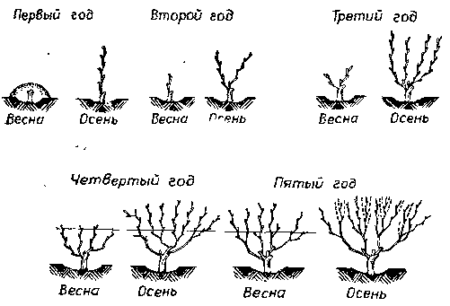

Autumn is the time for gardeners to harvest and carefully prepare the vineyard for wintering. This event involves annual pruning and other manipulations.
First year
In early April, you can remove the shelter and tie up the vine so that the tops are looking in different directions. The central pagon must be removed. Leave the two lower kidneys. In summer, 2 shoots will grow from them. In autumn, do not touch a couple of eyes from below. Cut the rest. Insulate for the winter.
Second year
In autumn, cut off the long sleeve, leaving 2 branches. Also remove the stems that grow lower in the main, leave two buds. Form a replacement knot. Form fruit arrows as follows: cut vertical stems, leaving 4 buds each. In the second year, there should already be 4 shoots. Cover the vine.
Third year
Leave vertical replacement knots. In early August, cut off the stems by 10-20 cm, the so-called chasing. If the work is done earlier, the vine will release many unnecessary and useless branches. This procedure is needed in order to increase the quantity and improve the quality of the berries.
Formation of grape bushes
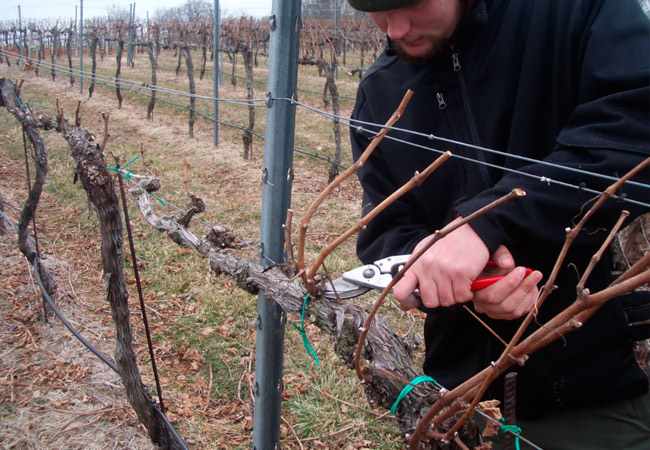

There are many ways to shape the vine. Let us dwell on the simplest and most understandable form - let the shoots grow horizontally, not vertically.
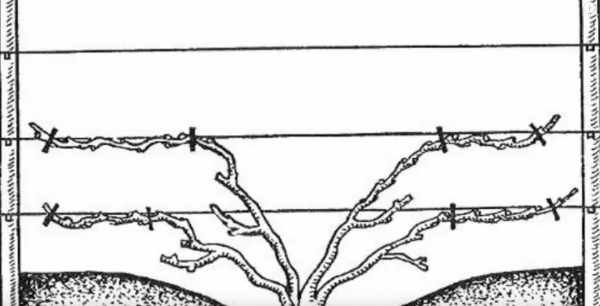

Video - Grapes Pruning a bush
Useful tips for beginners
Recommendations to help a novice grower cope with autumn pruning of the vine:
- For work, you need to choose a dry and sunny day. Rain and snow are dangerous for the plant: in conditions of moisture, the cuts on the vine become a gateway for infections. For this reason, it is desirable that fogs and precipitation are not expected not only on the day scheduled for pruning, but also on several subsequent ones.
- Cut shrubs and trees with a sharp and sterile tool. Before starting work, pruning shears or garden shears must be sharpened and thoroughly treated with alcohol.
- The procedure should begin with planning: inspect the bush, select the shoots necessary for removal and preservation, outline the places of the cuts, and only then proceed to the main work.
- When wielding a pruner, you need to act confidently and accurately: the cut is performed in one motion, without tearing, twisting and other manipulations that contribute to causing additional stress to the plant. An exception is the procedure for removing young stepsons: it is much easier to pinch them off with your fingers than to cut them off with a pruner.
- The cuts are always made at an acute angle.
- It is necessary to cut off the shoot above the eye, retreating from it about 0.5 cm.
- If, in the process of forming a bush, it is necessary to remove a thick vine, sprinkle the cut site with crushed coal or treat it with garden varnish for disinfection.
- After pruning and before dropping the vine, it must be treated with ferrous sulfate (ferrous sulfate). The concentration of the substance in the solution for young bushes should be 3%, for adults - 5%. Such a procedure will help the plant to endure stress and give the necessary energy for the next year.
Important! Iron vitriol protects the plant from pests and fungal diseases. In addition, the drug is indispensable as a mineral fertilizer, since the iron contained in it is in a form that is easily absorbed by plants.
Caring for grapes involves the obligatory pruning. Its main stage is performed in the fall, during the period when the buds entered the phase of organic dormancy. Not only the probability of successful wintering of the vine, but also how quickly and actively the bush will begin to develop in the spring, and how many fruit brushes will form on it, directly depends on how competently the manipulation is carried out.
Errors
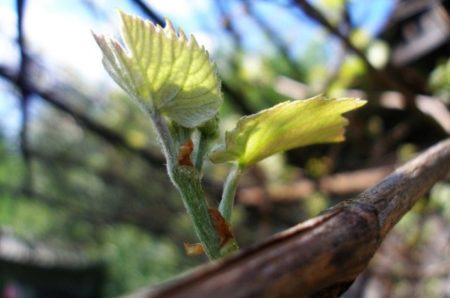

The most common mistakes lead to loss of yield, poor plant development or even death.
Minimum top cut
Long, large and beautiful branches are "a pity" to cut. Trimming is done "lightly". As a result, there is a lack of light for the vine, it becomes thin and the bush overgrows. The berry becomes shallow. Correctly you need to remove up to 70-90% of the gain.
The wrong shoots are cut
Novice growers either cut off all the young shoots and leave the old vine, or vice versa - the adult vine is removed and the young shoots are left. A double mistake is allowed. It is correct to cut out every year the shoots that have already borne fruit, as well as the thin vine thickening the bush. To get the harvest next year, it is advisable to leave a bole with several sleeves and young branches.
Hemp
The size of the hemp left is not taken into account, it is either cut off without a trace, or left too large. On adult shoots, according to the rules, no more than three cm should remain. On new vines, so that the cut does not rot, the stump does not need to be left.
Stepping
Young shoots do not break off, and they grow all summer. Or, on the contrary, they are cut completely flush with the main branch. It will be correct to leave two leaves and break off the stepsons above, removing the top.
Preliminary activities
Before you start pruning old or young grapes, you need to properly prepare the vine. Such preparations will help the bushes to cope with stress more easily (Figure 4).
Note: First of all, it is necessary to carefully examine all the bushes for the presence of dry, damaged or diseased branches. They are removed first, since such shoots can cause infection of the entire plant.
In addition, in the fall, you need to remove all young green growth from each shoot. These parts of the grapes only consume nutrients and, if not removed, can seriously weaken the plant and impair its wintering. It is also necessary to remove all remaining fruit clusters and remove the leaves from the grapes.


Figure 4. Before starting work, the vine must be freed from the remaining fruits and leaves
When all the preparatory activities are completed, you can take turns removing the lashes from the support and start cutting them.
The meaning of autumn pruning
The grape vine has an interesting feature - polarity. It manifests itself in the fact that shoots from the upper eyes of last year's vine develop faster and better. In the middle and lower parts of the vine, the eyes are weaker or do not shoot at all.
Many new buds and shoots grow every year. The plant cannot provide all of them with adequate nutrition. Therefore, vines form, leaving as many shoots as the root system can "feed".
Fall pruning is all about regulating growth and fruiting over the next season. Correctly performed procedure contributes to high yields and uniform plant growth.
With the wrong approach, the balance is disturbed, which leads to the strengthening of one of the processes at the expense of the weakening of the other - growth / yield.
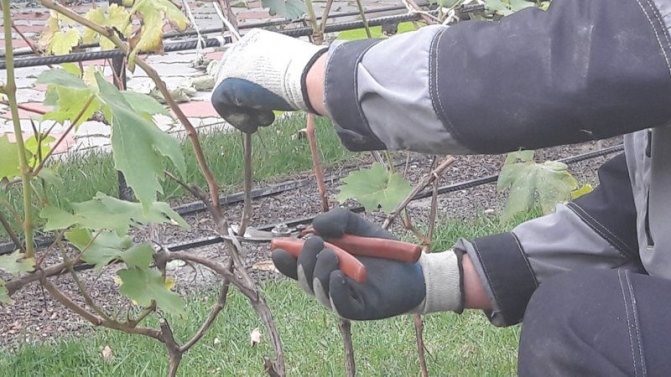

If the grapes are not pruned
A free-growing vine is constantly lengthening, the arms expand, the size of the bush increases significantly. But the root system is not able to provide all the formed shoots and bunches with the necessary nutrition.
This leads to the crushing of the berries and a deterioration in their taste already in the first year of free growth. The next year, the size and number of berries in the bunches will decrease even more, and after a few years the bush takes the form of wild grapes.
How to prune a gazebo bush
In regions with a temperate climate, frost-resistant, non-covering grape varieties are very popular among winegrowers. They are successfully grown on an arch or a gazebo. Growing up, such grapes acquire a spreading shape, while the length of the shoots exceeds 4 m. To cut such grapes, you will have to decide on the best procedure for the procedure. Pruning is suitable for an arbor plant:
- semi-covering;
- cordon;
- cordon with 1 shoulder;
- fan.
The most popular was the semi-covering shaping. With this procedure, vines are removed from the sleeve, which are placed on the upper wire of the trellis or arch. Unlike the first sleeve, the spare is placed on the lower trellis (its length is the same).
1 sprouting shoot remains at the bottom. It is shortened every fall. In regions with cool climatic conditions, the shoots are covered with the lower sleeve. The correct procedure allows you to get good growth of a new shoot in the summer, which, with subsequent pruning, actively grows and bears fruit.
Pruning an adult vineyard
If during the first three years the vineyard was looked after properly, then the further formation of the bush will not be particularly difficult. In this case, you can adhere to one of the formation schemes, which will be described below, or simply use the basic principles of pruning:
- Shoots that have borne fruit in the current year should be removed completely.
- Cut the lowest branch on the sleeve, leaving 2-3 eyes and replacing it with new shoots.
- Fruit-bearing arrows are cut into 5-10 buds.
- Shoots 10-12 cm thick are called fattening. They need to be removed.
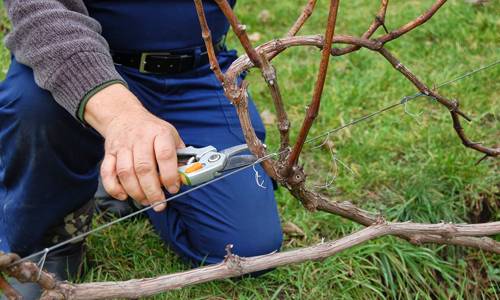

Particular attention should be paid to pruning fruiting arrows, which in future years should please with the harvest. After pruning, they must be covered, and when grown in the southern regions, they must be tied to a trellis.
With severe winter frosts, the upper buds may freeze out, but in general the shoot will remain alive and fruitful.
List of required tools and materials
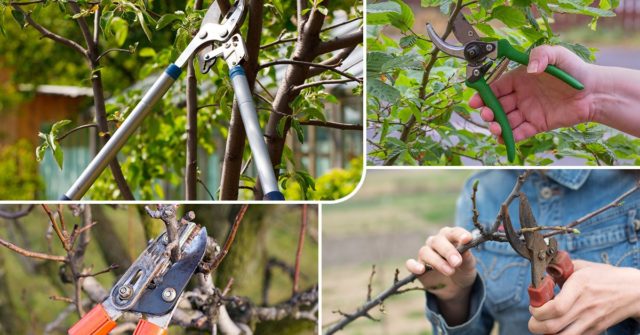

The most common and effective one when working in a vineyard is the usual set of equipment:
- Pruner, which is necessary, especially in the first years of plant life. It easily cuts thin rods, leaving the most even wound surface.
- Hacksaw or reinforced secateurs. Used for rejuvenating pruning of aged vines.
- Secateurs with two cutting blades. It is used by professionals to obtain even cuts on sleeves with a diameter of 2.0-2.5 centimeters for not old creepers.
- Hacksaw, bow saw for wood. It is used for pruning on old vines of grapes, the thickness of the trunk of which is 6-10 centimeters.

